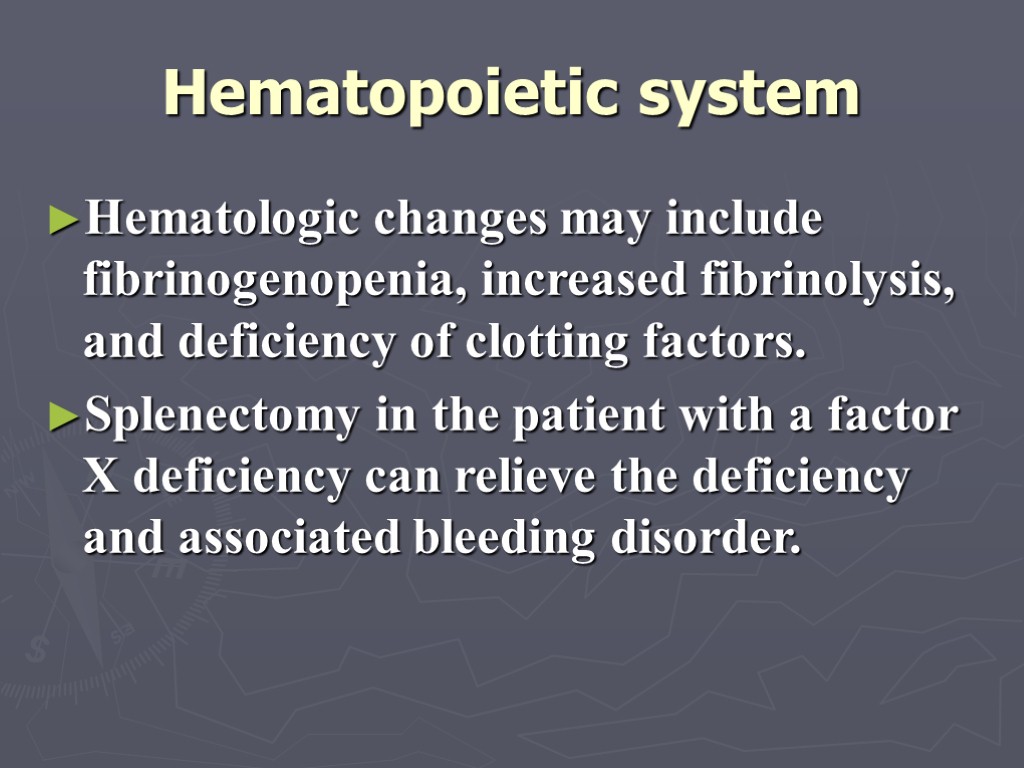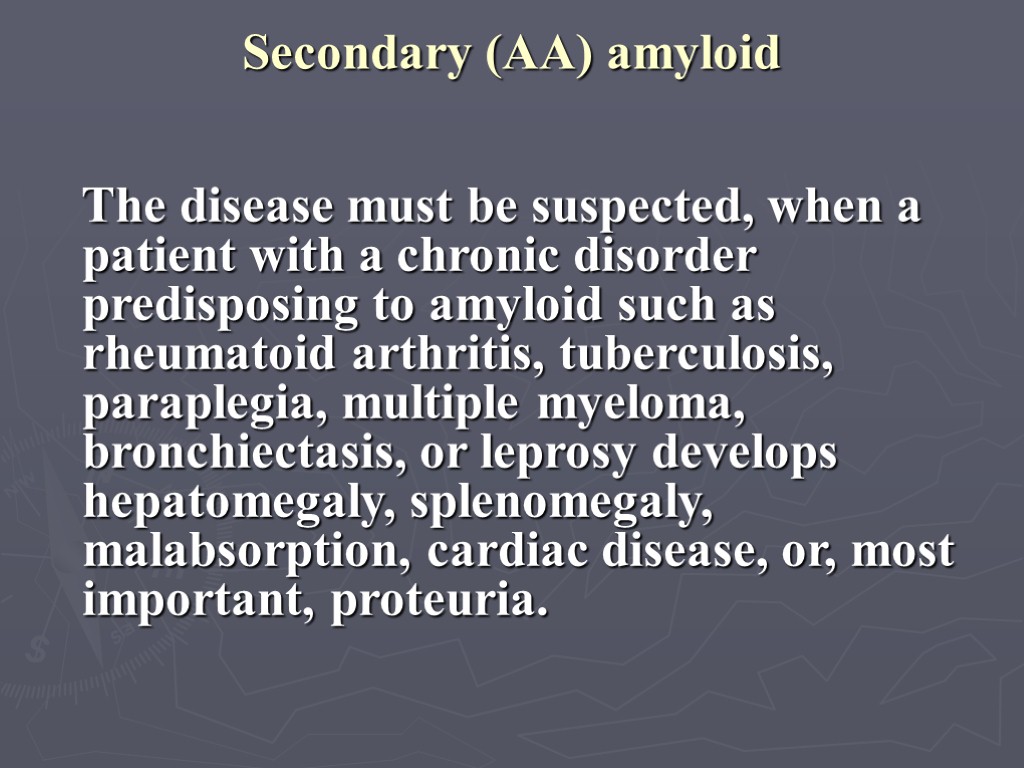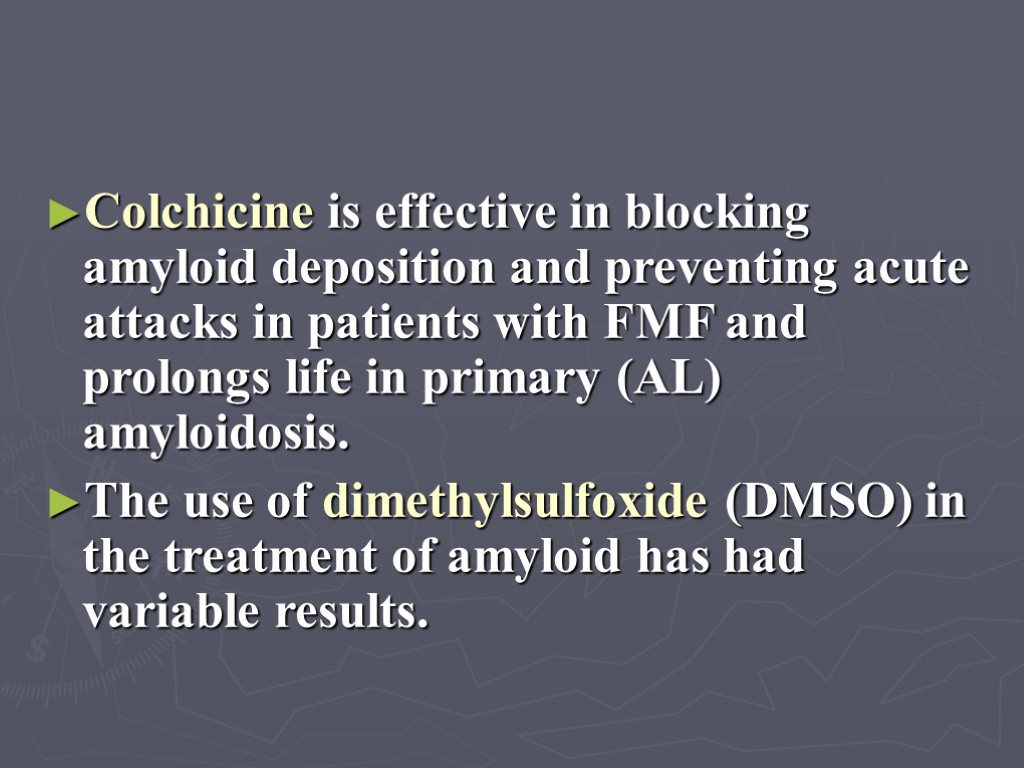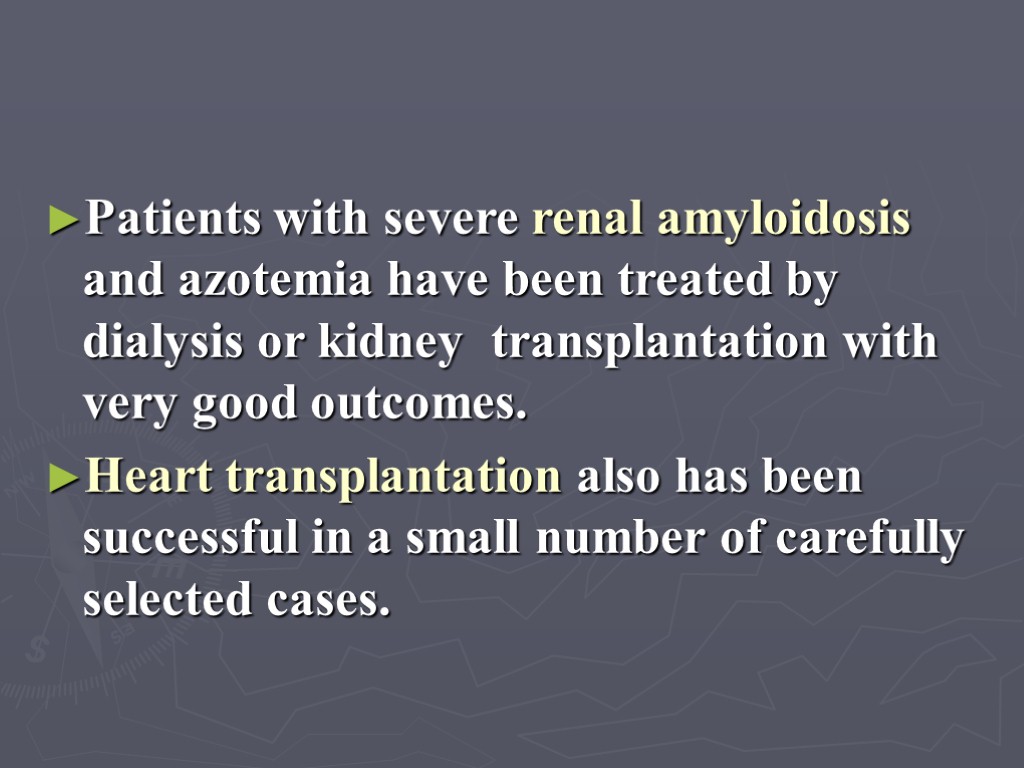AMYLOIDOSIS DEFINITION AND CLASSIFICATION Amyloidosis may be defined


AMYLOIDOSIS DEFINITION AND CLASSIFICATION Amyloidosis may be defined as the extracellular deposition of the fibrous protein amyloid in one or more sites of the body. It can be deposited locally, where it has no clinical consequences, or it may involve any organ of the body, leading to severe pathophysiologic changes.

History of amyloidosis It was named by Virchow in 1854 on the basis of its color after staining with iodine and sulfuric acid. This protein has unique ultrastructural, x-ray diffraction, and biochemical characteristics Clinical diagnosis is often not made until the disease is far advanced. There are multiple clinically and biochemically different forms of amyloid.

Classification of amyloidosis primary (AL type) amyloidosis amyloid associated with multiple myeloma (AL type) secondary or reactive (AA type) amyloidosis associated with chronic infectious heredofamilial amyloidosis (AF- prealbumin type), renal, cardiovascular, plus familial Mediterranean fever (AA type) local amyloidosis (focal, tumor-like deposits ) amyloidosis associated with aging amyloid associated with hemodialysis.

PATHOLOGY AND STRUCTURE Amyloid is amorphous, eosinophilic, extracellular, and ubiguitous in distribution. The organs may have a rubbery consistency and a waxy, pink or gray appearance. Organ enlargement, especially of the liver, kidney, spleen, and heart, may be prominent. The heat may show focal or diffuse interstitial deposits in the myocardium, endocardium, or pericardium. In the kidney, the glomerulus is affected, although interstitial, peritubular, and vascular amyloid occur.

CLINICAL MANIFESTATIONS The clinical manifestations of amyloidosis are varied and depend entirely on the area of the body which is involved.

Kidney Renal involvement may consist of mild proteinuria or frank nephrosis. The urinary sediment may show only a few red blood cells. The renal lesion is usually not reversible and in time leads to progressive azotemia and death. When azotemia finally develops, the prognosis is grave.

Nephrotic syndrome (NS ) This diagnosis implied that a patient excretes more, than 3,5 g protein per 24 h, the proteinuria consists mainli of aibumin, and that the patient has reduced serum albumin, edema, hyperlipidemia. Common causes of the NS include also, minimal change disease, idiopathic membranous glomerulopathy, focal glomerulosclerosis, and diabetic glomerulosclerosis.

Renal amyloid (RA) The mean survival of patients with RA was 29 months, in a few cases -regression of the RA. The use of chronic hemodialysis and kidney transplantation has improved the prognosis. Hypertension occur in long-standing RA. Renal tubular acidosis, renal vein thrombosis. Localized accumulation of amyloid may be noted in the ureter, bladder. Renal pathology occurs in AA, AL, and many forms of heredofamilial disease.

Liver While hepatic involvement is common, liver function abnormalities are minimal and occur late in the disease. The two tests most useful in indicating hepatic amyloid are: the Bromsulphalein (BSP) extraction and serum alkaline phosphatase activity. No liver function tests are truly specific or sensitive for amyloid. Liver scans produce variable and nonspecific results. Portal hypertension occurs, but is uncommon.

Liver and spleen Hepatomegaly is common, and AL hepatic amyloid is usually accompanied by the NS and congestive heart failure. Prognosis is poor, and one group of 80 patients with proven AL hepatic amyloid had a median survival of 9 months. Amyloidosis of the spleen characteristi- cally is not associated with leukopenia and anemia.

Heart Cardiac manifestations consist primarily of congestive failure and cardiomegaly and arrhythmias. Cardiac amyloidosis is common in primary (AL) and heredofamilial amyloidosis. Although the cardiac manifestations predominantly reflect diffuse myocardial amyloid, the endocardium, valves, and pericardium may be involved as well.

Skin The lesions of the skin are characteristic of primary (AL) amyloidosis (55%). Its may consist of slightly raised, waxy papules or plaques in the folds of the axillae, anal, or inguinal regions, the face and neck, or mucosal areas of ear or tongue. Periorbital echymoses ("black eye syndrome") have been reported. The lesions are pruritic. Gentle rubbing of the skin may induce bleeding into the skin, leading to purpura. Cutaneous involvement occur in secondarv amvloidosis (42%); in hereditary amyloidosis - (100%).

Gastrointestinal tract (GT) GT symptoms are common in all types of amyloidosis. They may result from direct involvement of the GT or from infiltration of the autonomic nervous system with amyloid. They include: obstruction, ulceration, malabsorption, hemorrhage, protein loss, and diarrhea.

The tongue Infiltration of the tongue occasionally leads to macroglossia. When not enlarged, the tongue may become stiffened and firm to palpation. Infiltration of the tongue is characteristic of primary amyloidosis (AL) or amyloidosis accompanying multiple myeloma, it is occasionally seen in the secondary (AA) form of the disease.

The esophagus, stomach, large intestine GT-bleeding may occur in esophagus, stomach or large intestine. Amyloid infiltration of the esophagus may lead to nonrelaxing lower sphincter, nonspecific motility or achalasia. Small bowel lesions may lead to obstruction. Malabsorption syndrome is seen at times. Amyloidosis of the stomach may mimic gastric carcinoma with obstruction, achlorhydria.

Nervous system (NS) Peripheral neuropathy, postural hypotension, inability to sweat, hoarseness, and sphincter incompetence (in the heredofam. forms). The cranial nerves are generally spared. Carpal turnnel syndrome may be caused by primary (AL) amyloidosis and chronic hemodialysis. Amyloid occurs in the central NS as a component of senile plaques. The protein concentration in the cerebral spinal fluid may be increased.

Endocrine Amyloid may infiltrate the thyroid or other endocrine glands, but rarely causes endocrine dysfunction. Local amyloid desposits accompany medullary carcinoma of the thyroid. Amyloid is often found in the adrenal gland, pituitary gland and pancreas.

Joints Amyloid can directly involve articular structures by its presence in the synovial membrane and synovial fluid or in the articular cartilage. Amyloid arthritis can mimic rheumatic disease. Most patients with amyloid arthropathy have multiple myeloma. Amyloid infiltration of muscle may lead to a pseudomyopathy.

Respiratory system The nasal sinuses, larynx, and trachea may be involved by accumulations of AL amyloid which block the ducts. Amyloidosis involves the bronchi and alveolar septa diffusely most frequently in primary (AL) amyloidosis and in the disease associated with dysproteinemia (30%). Amyloid also may be localized in pulmonary parenchyma and may resemble a neoplasm.

Hematopoietic system Hematologic changes may include fibrinogenopenia, increased fibrinolysis, and deficiency of clotting factors. Splenectomy in the patient with a factor X deficiency can relieve the deficiency and associated bleeding disorder.

HEREDOFAMILIAL AMYLOIDOSIS Amyloidosis of familial Mediterranean fever (FMF), which is inherited as an autosomal recessive disorder, and is an AA type of amyloid. Clinical manifectations of FMF are: fever; joint pain; poliserositis; skin rash; mostly autosomal recessive. Ethnic association: Sephardic Jews, Armenians, Kurds.

DIAGNOSIS The specific diagnosis of amyloidosis depends on obtaining a tissue specimen by biopsy and the demonstration of amyloid with appropriate stains.

Primary systemic (AL) amyloid Primary systemic (AL) amyloid should be considered in any individual with a diffuse non-inflammatory infiltrative disease involving mesenchymal tissues (blood vessels, heart, gastrointestinal tract), or parenchymal tissues (kidney, liver, spleen, adrenal).

Secondary (AA) amyloid The disease must be suspected, when a patient with a chronic disorder predisposing to amyloid such as rheumatoid arthritis, tuberculosis, paraplegia, multiple myeloma, bronchiectasis, or leprosy develops hepatomegaly, splenomegaly, malabsorption, cardiac disease, or, most important, proteuria.

When the diagnosis is suspected It need to perform biopsy of rectum or kidney, or liver. All tissues must be stained with Congo red and examined in the polarizing microscope for green birefringence. A modified potassium permanganate stain will allow differentiation of AA type from AL amyloid.

THERAPY There is no specific therapy for amyloido sis. Therapy should be directed at: (1) decreasing chronic antigenic stimuli that produce amyloid (2) inhibition of the synthesis and extracellular deposition of amyloid fibrils (3) promoting lysis or mobilization of existing amyloid deposits

A variety of agents have been used to treat amyloidosis. Proof of their efficacy is not available. Recent trials have indicated that: prednisone /melphalan regimen or prednisone /melphalan/ colchicine program prolongs life.

Colchicine is effective in blocking amyloid deposition and preventing acute attacks in patients with FMF and prolongs life in primary (AL) amyloidosis. The use of dimethylsulfoxide (DMSO) in the treatment of amyloid has had variable results.

Patients with severe renal amyloidosis and azotemia have been treated by dialysis or kidney transplantation with very good outcomes. Heart transplantation also has been successful in a small number of carefully selected cases.

PROGNOSIS In patients with multiple myeloma prognosis is poor (6 months). Generalized amyloidosis leads to death in several years (4 - 5). Causes of death: heart disease and renal failure. Sudden death, presumably due to arrhythmias, is common.
engl_amyloidosis_5_kurs_prezentaciya.ppt
- Количество слайдов: 30

